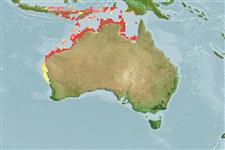>
Eupercaria/misc (Various families in series Eupercaria) >
Nemipteridae (Threadfin breams, Whiptail breams)
Etymology: Scaevius: Latin, scaeva = the wrong way, clumsy.
Eponymy: Baron Pierre Bernard Milius (1773–1829) was a French naval officer, naturalist and civil servant who took part in an exploratory voyage (1804) of the Mascarene Islands, Indian Ocean, under Nicolas Baudin, during which he became friends with Bory. [...] (Ref. 128868), visit book page.
Environment: milieu / climate zone / intervalo de profundidade / distribution range
Ecologia
marinhas associadas(os) a recifes; intervalo de profundidade 1 - 20 m (Ref. 9785). Tropical; 7°S - 30°S, 109°E - 141°E (Ref. 3810)
Western Pacific: northwestern Australia from Gulf of Carpentaria to Abrolhos Islands. Also known from Papua New Guinea (Ref. 6192). This species has been commonly referred to as Scaevius nicanor Whitley, but Scaevius milii is the older name.
Tamanho / Peso / Idade
Maturidade: Lm ? range ? - ? cm
Max length : 20.0 cm SL macho/indeterminado; (Ref. 3810); common length : 15.0 cm SL macho/indeterminado; (Ref. 3810)
Espinhos dorsais (total) : 10; Raios dorsais moles (total) : 9; Espinhos anais: 3; Raios anais moles: 7. Scales on top of head not reaching to level of eyes. Snout, suborbital, interorbital, and temporal parts of head naked. Posterior margin of suborbital denticulate, a small spine in upper corner. 5 or 6 transverse rows of cheek scales. Preopercle serrate, opercle scaly. Lower limb of preopercle naked. Upper margin of opercle with a small, flat, rounded spine. Pectoral fins short, not reaching to level of anus. Pelvic fins long, reaching to level of anus. Color: Dark olive on top of head, back paler, ventral surface white. 2 blue stripes on snout, the first joining eyes through nostrils, the second across front of snout. 2 narrow blue lines below eye crossing suborbital.
Body shape (shape guide): fusiform / normal; Cross section: oval.
Abundant on shallow inshore reefs and adjacent sand or mud bottoms. Feeds on small fishes and benthic invertebrates. Unimportant as a food fish. No major fishery exists.
Life cycle and mating behavior
Maturidade | Reprodução | Desova | Ovos | Fecundidade | Larvas
Russell, B.C., 1990. FAO Species Catalogue. Vol. 12. Nemipterid fishes of the world. (Threadfin breams, whiptail breams, monocle breams, dwarf monocle breams, and coral breams). Family Nemipteridae. An annotated and illustrated catalogue of nemipterid species known to date. FAO Fish. Synop. 125(12):149p. Rome: FAO. (Ref. 3810)
Categoria na Lista Vermelha da IUCN (Ref. 130435: Version 2025-1)
Ameaça para o homem
Harmless
Utilização humana
Pescarias: pouco comercial
Ferramentas
Relatórios especiais
Descarregue XML
Fontes da internet
Estimates based on models
Preferred temperature (Ref.
123201): 26.7 - 28.7, mean 28.3 °C (based on 282 cells).
Phylogenetic diversity index (Ref.
82804): PD
50 = 1.0000 [Uniqueness, from 0.5 = low to 2.0 = high].
Bayesian length-weight: a=0.01445 (0.00683 - 0.03057), b=2.98 (2.81 - 3.15), in cm total length, based on LWR estimates for this (Sub)family-body shape (Ref.
93245).
Nível Trófico (Ref.
69278): 4.0 ±0.63 se; based on food items.
Resiliência (Ref.
120179): Elevada, tempo mínimo de duplicação da população menor que 15 meses (Preliminary K or Fecundity.).
Fishing Vulnerability (Ref.
59153): Low vulnerability (14 of 100).
🛈
Nutrients (Ref.
124155): Calcium = 70 [43, 149] mg/100g; Iron = 0.684 [0.321, 1.703] mg/100g; Protein = 19.2 [17.3, 20.9] %; Omega3 = 0.155 [0.090, 0.265] g/100g; Selenium = 22.6 [12.4, 42.8] μg/100g; VitaminA = 100 [27, 309] μg/100g; Zinc = 1.31 [0.88, 1.93] mg/100g (wet weight);
